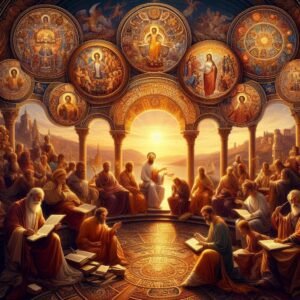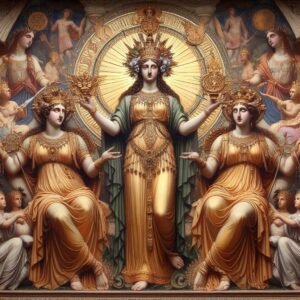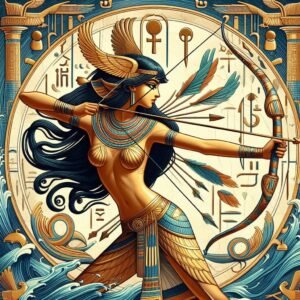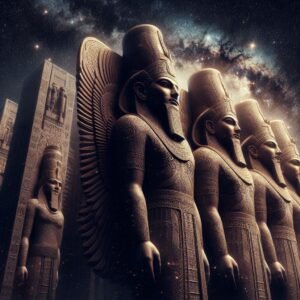
Marduk was a prominent god in ancient Mesopotamian religion, particularly revered in the city of Babylon. Initially, a god of thunderstorms, he rose to become the chief deity of Babylon and was later known simply as Bel, meaning “Lord”.
Syncretism with Enlil
Marduk was syncretized with Enlil. This process occurred during the time of the Isin II dynasty, when the religious and political influence of Babylon grew. The syncretism involved merging aspects of Enlil, the chief deity of Nippur, with Marduk, the patron god of Babylon. This included switching the names of city walls, with Imgur-Enlil and Nimit-Enlil in Babylon and Imgur-Marduk and Nimit-Marduk in Nippur. This syncretism helped elevate Marduk’s status to that of the supreme deity in the Mesopotamian pantheon.
Several other gods in Mesopotamian mythology were syncretized over time. For example, the Sumerian god Enki was syncretized with the Akkadian god Ea, both representing wisdom and water. Similarly, the goddess Inanna was merged with the Akkadian goddess Ishtar, embodying love, beauty, and war. The god Ninurta, originally a Sumerian deity of agriculture and healing, was later associated with the Akkadian god Ningirsu. These syncretisms helped unify various cultural and religious practices across the region.
The Enuma Elish
Marduk is best known for his role in the Babylonian creation myth, the Enuma Elish, where he defeats the chaos monster Tiamat and creates the world from her body.
The Enuma Elish, also known as “The Seven Tablets of Creation,” is a Babylonian creation myth that dates back to the late 2nd millennium BCE. It was discovered in the ruined Library of Ashurbanipal at Nineveh in 1849. The myth is written in Akkadian on seven clay tablets and begins with the words “When on High” (Enuma Elish). It describes the creation of the world, the rise of the god Marduk, and his victory over the chaos monster Tiamat.
In the story, the universe begins in a state of chaos, represented by the primordial waters of Apsu (fresh water) and Tiamat (salt water). From their union, the younger gods are born, but their noise disturbs Apsu, who plans to kill them. Tiamat warns her son Ea, who kills Apsu. Tiamat then creates an army of monsters to avenge Apsu’s death, but Marduk, the champion of the younger gods, defeats her and creates the world from her body.
Marduk defeated Tiamat in a dramatic battle. He first captured her in a net and then used the winds to force her mouth open. Marduk shot an arrow into her belly, killing her. After her defeat, he divided her body, using one half to create the sky and the other half to create the earth. This victory established Marduk as the supreme deity and brought order to the cosmos. The myth ends with the establishment of Marduk’s supremacy and the creation of humanity to serve the gods.
Symbols
Marduk, the chief deity of Babylon, is associated with several symbols and animals. His primary symbol is the spade, which represents his role as a god of agriculture and creation. The animal most closely linked to Marduk is the Mušḫuššu, a dragon-like creature often depicted in Mesopotamian art. This “snake-dragon” symbolizes Marduk’s power and authority. Additionally, Marduk is sometimes associated with the planet Jupiter, reflecting his importance in Babylonian astrology.
Worship
The most significant temples dedicated to Marduk, the chief god of Babylon, were the Esagila and the Etemenanki.
The Esagila temple, dedicated to Marduk, was a central and significant structure in ancient Babylon. Located south of the Etemenanki ziggurat, the temple complex measured about 200 meters on its longest side and featured three vast courtyards surrounded by intricate chambers. The inner sanctum of the temple housed the statues of Marduk and his consort Sarpanitum, and it was a focal point for religious activities. The temple also included a sacred lake called the Abzu, representing the waters of Marduk’s father, Enki. Over centuries, the Esagila was rebuilt and maintained by various Babylonian kings, including Nebuchadnezzar II, who completed its final form.
The Etemenanki, often associated with the biblical Tower of Babel, was a massive ziggurat that stood near the Esagila and was also dedicated to Marduk. These structures were central to Babylonian religious life and reflected the city’s devotion to their patron deity. Etemenanki, meaning “Temple of the Foundation of Heaven and Earth,” was a significant ziggurat dedicated to the Mesopotamian god Marduk in the ancient city of Babylon. Located about 90 kilometres south of modern-day Baghdad, Iraq, it now exists only in ruins. The ziggurat was constructed and reconstructed multiple times, with notable efforts by Nebuchadnezzar II, who claimed to have made it “the wonder of the people of the world”.
Etemenanki was constructed using mud-brick, a common building material in ancient Mesopotamia. The ziggurat featured multiple terraced levels that receded as they rose, creating a stepped pyramid shape. The structure was adorned with bitumen and burnt brick facing, enhancing its durability and appearance.
Etemenanki has been associated with the Tower of Babel, primarily due to its impressive structure and its location in Babylon. The biblical story of the Tower of Babel describes a massive tower built to reach the heavens, which aligns with the grand design of Etemenanki, a ziggurat dedicated to the god Marduk. Additionally, the name “Babel” in the Bible is often linked to Babylon, further strengthening this association. Scholars believe that the story of the Tower of Babel was inspired by the real-life Etemenanki, symbolizing human ambition and the divine intervention that scattered people across the earth.
Apart from the biblical story of the Tower of Babel, Etemenanki is also linked to other myths and stories. One notable tale is the Sumerian story of Enmerkar and the Lord of Aratta, which shares elements of grand construction and divine intervention. Additionally, Etemenanki’s significance in Babylonian culture meant it was often referenced in various Mesopotamian texts and inscriptions, highlighting its importance as a religious and cultural symbol.
In Marduk’s temples, various rituals were performed to honour and appease the god. One of the most significant ceremonies was the Akitu festival, celebrated during the New Year. This festival involved elaborate processions, offerings, and prayers to ensure the city’s prosperity and the god’s favour. Daily rituals included offerings of food, drink, and incense, as well as recitations of hymns and prayers.
Subscribe to our post updates - Don't miss a thing!!







